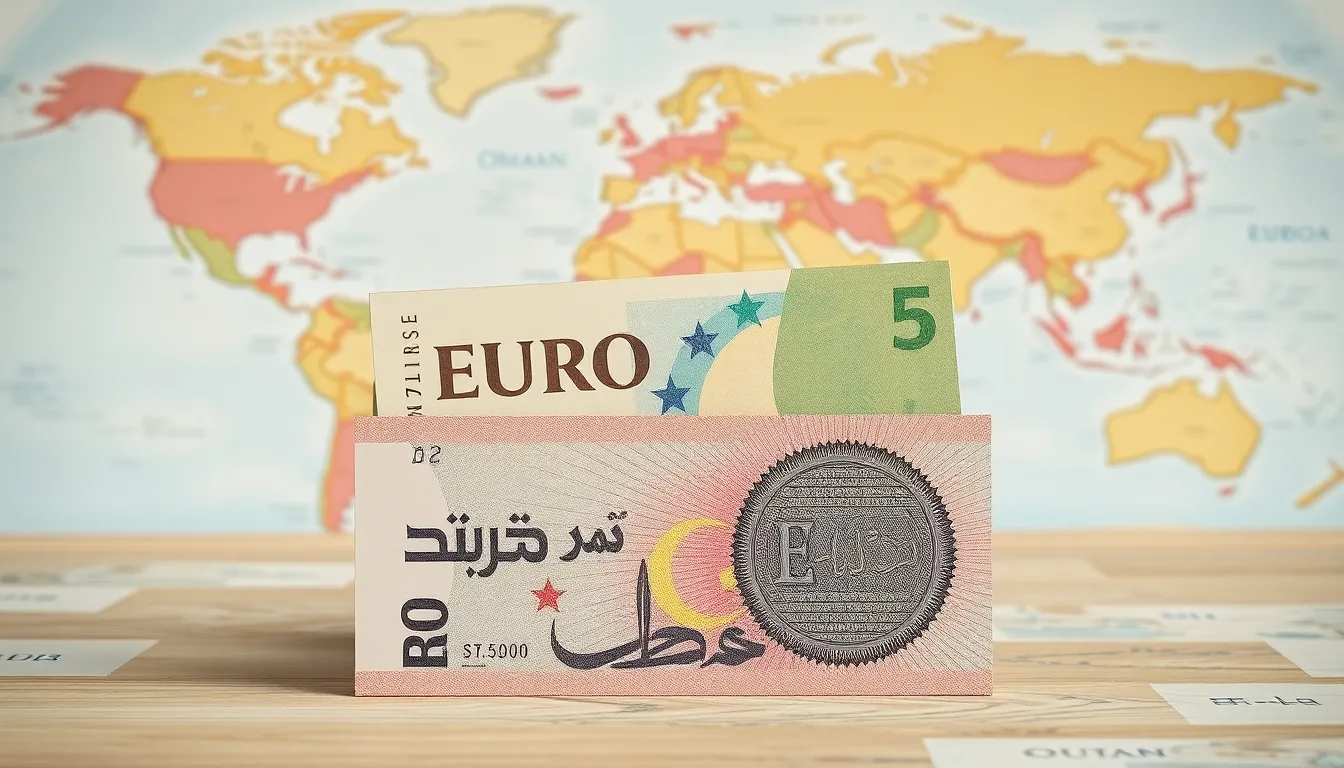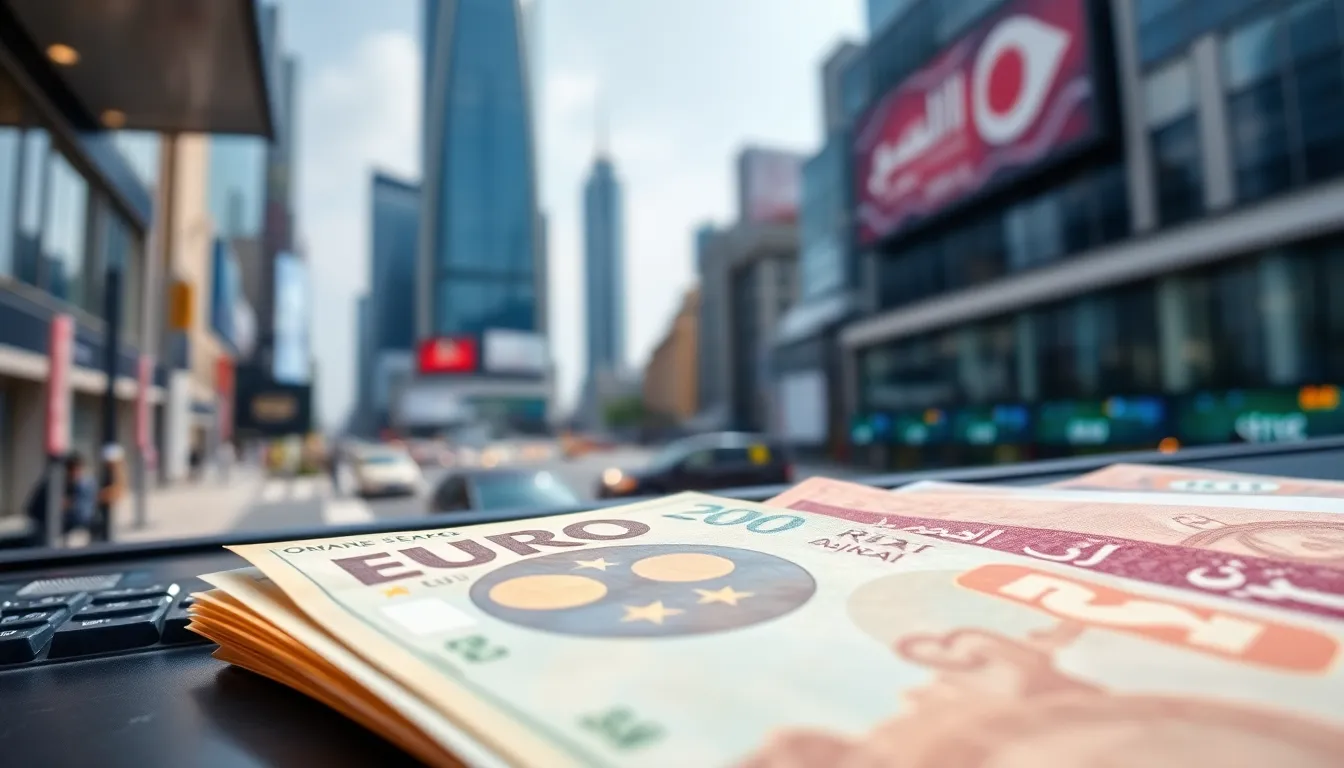Navigating the world of currency exchange can feel like trying to find a needle in a haystack, especially when it comes to the EUR to OMR exchange rate. Whether you’re planning a trip to Oman or just curious about how far your euros will stretch, understanding this exchange rate is key. After all, no one wants to show up at a souk only to realize their euros won’t buy them a single date!
With the euro and the Omani rial dancing to their own economic tunes, staying informed can save travelers and investors alike from some serious wallet woes. So buckle up as we dive into the ins and outs of the EUR to OMR exchange rate, making sure you’re equipped with all the knowledge you need to make your money work for you. Who knew currency exchange could be this entertaining?
Table of Contents
ToggleOverview of EUR to OMR Exchange Rate
The EUR to OMR exchange rate represents the value of the Euro against the Omani Rial. Understanding this rate is essential for anyone engaging in currency conversion, whether for travel or investment purposes. Currency fluctuations impact the purchasing power of travelers visiting Oman. Rates change continuously, influenced by factors such as economic conditions, political stability, and market sentiment.
The current exchange rate can affect financial decisions significantly. For example, a lower exchange rate means fewer Rials received for each Euro exchanged, impacting travel budgets. Conversely, a higher rate offers more Rials, enhancing purchasing power within Oman. Tracking these rates helps individuals make informed decisions regarding timing and amounts for currency exchange.
Investors also closely monitor the EUR to OMR rate. Variability in the exchange rate provides opportunities for trading strategies. A stable exchange rate may foster investment confidence, while sharp fluctuations typically introduce uncertainty.
To stay updated, individuals often rely on various financial platforms and currency converters. These sources offer real-time data, crucial for minimizing losses during transactions. Regularly checking exchange rates ensures individuals remain aware of current trends. An informed approach to currency exchange can lead to significant savings, particularly for those undertaking larger transactions.
Each conversion transaction should reflect the latest market data to guarantee fair rates. Familiarity with the exchange rate enhances financial literacy and encourages savvy decision-making when managing currencies.
Historical Trends of EUR to OMR

Understanding the historical trends of the EUR to OMR exchange rate reveals valuable insights for travelers and investors. Exchange rates have varied over the years due to multiple factors, making it crucial to analyze these trends.
Key Factors Influencing Exchange Rate
Economic conditions exert significant influence on the EUR to OMR exchange rate. Inflation rates and interest rates of both the Eurozone and Oman impact currency strength. Political stability, or lack thereof, also plays a vital role; stable governments tend to attract foreign investment, strengthening their currencies. Supply and demand dynamics affect currency values as well; when demand for Euros rises, so does its value against the Omani Rial. Additionally, global events, such as economic crises or trade agreements, shift market perceptions, altering exchange rates.
Major Events Impacting Exchange Rate Fluctuations
Significant events have shaped the EUR to OMR exchange rate throughout history. For instance, the financial crisis of 2008 saw the Euro weaken against various currencies, including the Omani Rial. Recent economic reforms in Oman aimed at diversification may impact future rates significantly. Brexit, which created uncertainty, affected the Euro’s stability and its relationship with other currencies. Moreover, global commodity price fluctuations influence the Omani economy, affecting the Rial’s strength. Understanding these events helps individuals anticipate market movements and make informed decisions on currency exchanges.
Current State of EUR to OMR Exchange Rate
The current state of the EUR to OMR exchange rate reveals notable fluctuations. These changes often reflect broader economic trends affecting both the Eurozone and Oman.
Analysis of Recent Movements
Recent movements in the EUR to OMR exchange rate showcase a trend of increasing volatility, primarily driven by external economic factors. Significant events, such as shifts in oil prices, have impacted the Omani economy, causing fluctuations in the Rial’s value against the Euro. Observing the past month’s data, the exchange rate saw a low of 0.40 OMR per EUR and a high of 0.42 OMR per EUR. Market analysts note that geopolitical events and changes in interest rates in the Eurozone continue to play a critical role in determining these exchange rates. Staying updated with financial news provides insight into potential future movements.
Comparison with Other Currency Pairs
Comparing the EUR to OMR exchange rate with other currency pairs highlights its unique characteristics. For instance, when examined alongside the EUR to USD rate, the EUR to OMR rate exhibits more pronounced volatility due to the smaller size of the Omani economy. As of the latest data, the EUR to USD exchange rate stands at approximately 1.05, while the EUR to OMR sits significantly lower, emphasizing the strength of the Omani Rial relative to the Euro. Currency traders often analyze multiple pairs to identify hedging opportunities. Monitoring a range of currency pairs enhances the ability to make informed trading decisions in a global market.
Forecasting the Future of EUR to OMR Exchange Rate
Predicting the EUR to OMR exchange rate requires careful analysis of various economic indicators and trends. Many experts emphasize the need for continuous monitoring of global economic conditions that influence currency values.
Expert Opinions and Predictions
Analysts are divided on the future trajectory of the EUR to OMR exchange rate. Some predict stabilization as European economies recover post-COVID, while others anticipate increased volatility driven by factors like inflation and geopolitical tensions. Market experts suggest that the Omani economy, heavily reliant on oil exports, could experience fluctuations based on global oil prices. Insights from financial institutions indicate that ongoing reforms in Oman could strengthen the Rial, leading to a more favorable exchange rate against the Euro in the long term.
Factors to Watch for Future Trends
Several key factors influence the EUR to OMR exchange rate. Economic data from the Eurozone, including GDP growth rates and employment figures, plays a vital role. Interest rate changes from central banks significantly affect investor sentiment. Political stability within Oman and Europe remains crucial, as uncertainty can lead to reduced foreign investment and currency value fluctuations. Furthermore, shifts in oil prices directly impact the Omani economy, creating ripple effects across the exchange rate. Keeping an eye on these variables allows individuals and investors to anticipate potential changes in currency dynamics.
Understanding the EUR to OMR exchange rate is essential for anyone engaging in travel or investment activities involving these currencies. By staying informed about current trends and historical patterns, individuals can navigate the complexities of currency exchange more effectively.
The fluctuations in this exchange rate can have significant implications for purchasing power and investment strategies. Monitoring economic indicators and geopolitical developments will empower travelers and investors to make more informed decisions.
Ultimately, being proactive in tracking the EUR to OMR exchange rate can lead to smarter financial choices and better outcomes in currency management.



